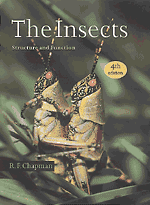Book contents
- Frontmatter
- Contents
- Preface
- Acknowledgments
- PART I The Head, Ingestion, Utilization and Distribution of Food
- PART II The Thorax and Locomotion
- PART III The Abdomen, Reproduction and Development
- PART IV The Integument, Gas Exchange and Homeostasis
- PART V Communication
- 20 Nervous system
- 21 Endocrine system
- 22 Vision
- 23 Mechanoreception
- 24 Chemoreception
- 25 Visual signals: color and light production
- 26 Mechanical communication: producing sound and substrate vibrations
- 27 Chemical communication: pheromones and chemicals with interspecific significance
- Taxonomic index
- Subject index
26 - Mechanical communication: producing sound and substrate vibrations
Published online by Cambridge University Press: 05 June 2012
- Frontmatter
- Contents
- Preface
- Acknowledgments
- PART I The Head, Ingestion, Utilization and Distribution of Food
- PART II The Thorax and Locomotion
- PART III The Abdomen, Reproduction and Development
- PART IV The Integument, Gas Exchange and Homeostasis
- PART V Communication
- 20 Nervous system
- 21 Endocrine system
- 22 Vision
- 23 Mechanoreception
- 24 Chemoreception
- 25 Visual signals: color and light production
- 26 Mechanical communication: producing sound and substrate vibrations
- 27 Chemical communication: pheromones and chemicals with interspecific significance
- Taxonomic index
- Subject index
Summary
Many insects communicate using vibrational signals. These may be air-or water-borne sounds, which are sometimes audible to humans, or they may be transmitted through the substrate on which the insect is resting. Sometimes the vibrations are purely adventitious, resulting from the insect's normal activities, such as the sounds produced by wing vibration in flight or by the mandibles of an insect chewing, but they often have some special significance for the insect and, in most cases, are produced independently of other activities.
Vibrations may be produced in water and solids with little or no anatomical specialization. By contrast, insects using airborne vibrations to communicate use structures and behaviors that enhance sound radiation. The structure transmitting vibrations to the air is known as the sound radiator; it is often a part of the wing which is suspended from the surrounding cuticle in a way that facilitates its free vibration.
A sound radiator functions most efficiently in producing sounds with wavelengths similar to or less than its own dimensions. Consequently, because of their small size, insects are constrained towards producing sounds with short wavelengths (and high frequencies). However, high frequency sounds attenuate more rapidly than lower frequency, longer wavelength sounds so they are less good for distance communication. In practice, airborne sounds produced by different insects cover a very wide range of frequencies and are often ultrasonic to humans (Fig. 26.1).
- Type
- Chapter
- Information
- The InsectsStructure and Function, pp. 680 - 703Publisher: Cambridge University PressPrint publication year: 1998



